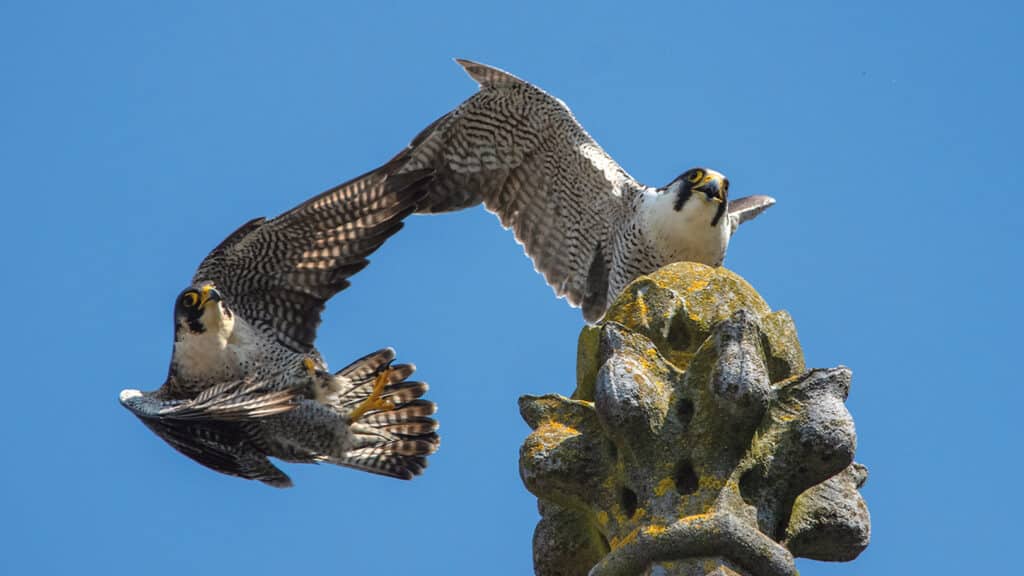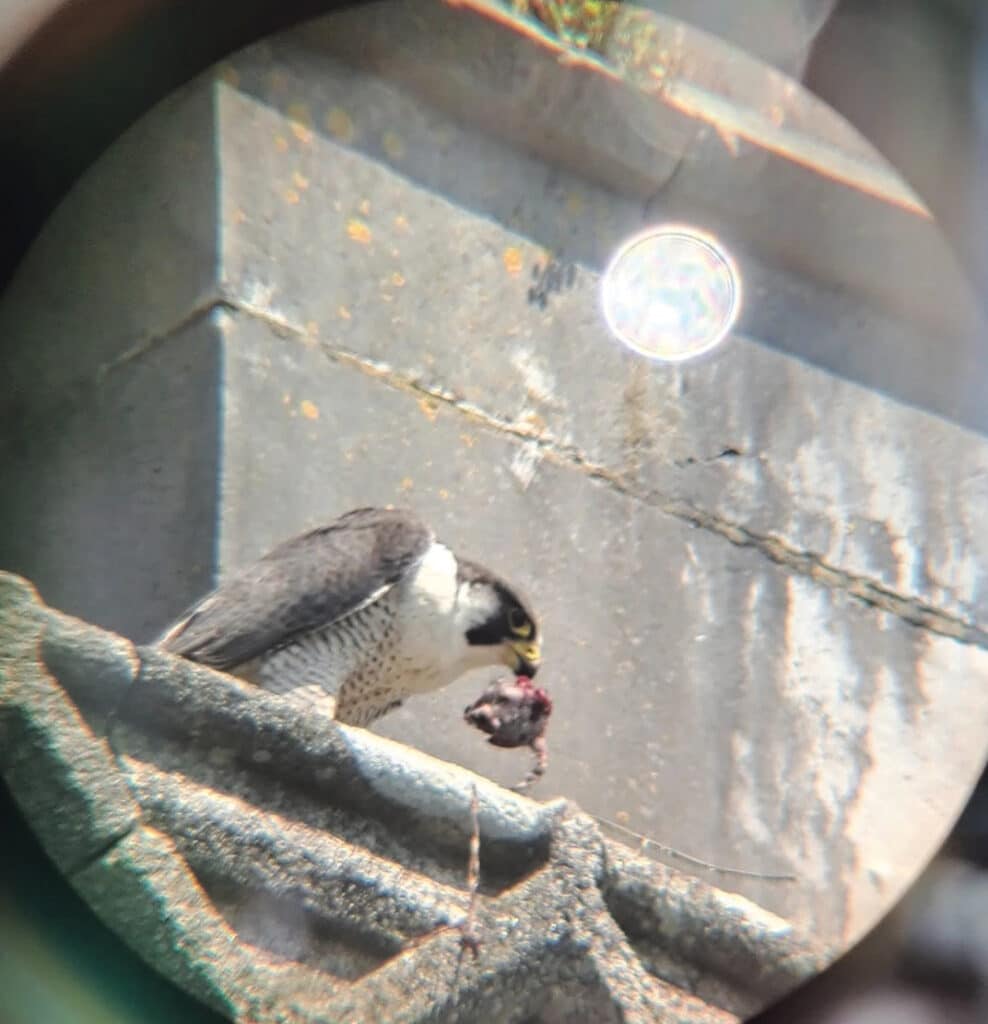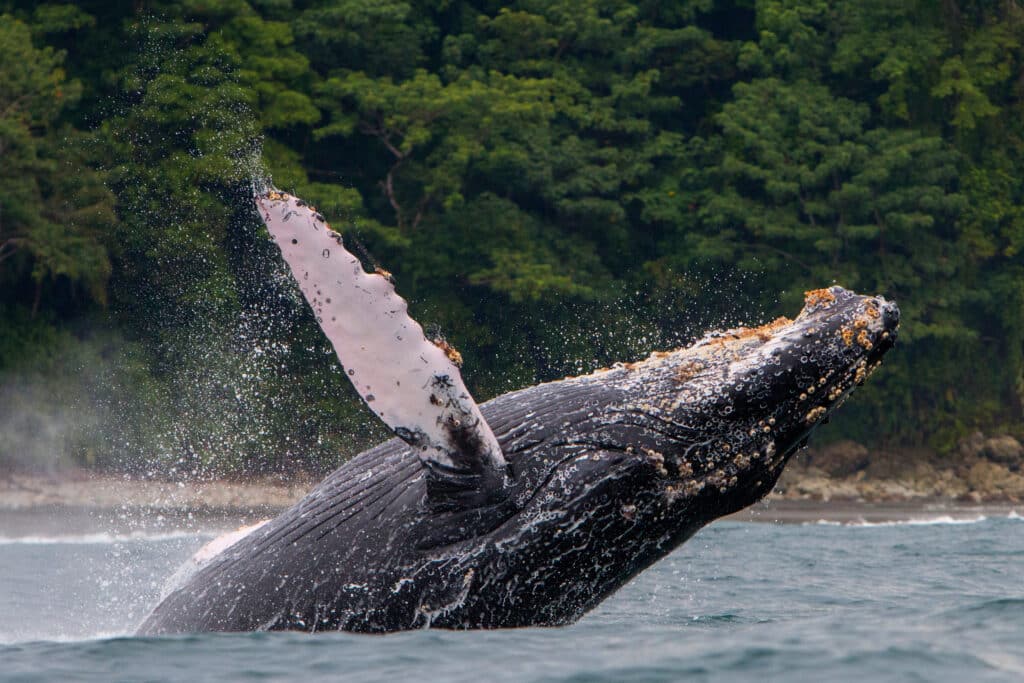Following her recent talk and viewing session to the public, Branch Committee member and local area National Parks and Wildlife Service (NPWS) Conservation Ranger, Claire Deasy, gives an account of Clonakilty’s newest resident bird of prey, the awe-inspiring peregrine falcon (scientific name: falco peregrinus; Irish name: fabhcún gorm).
This spring, residents in the neighbourhood of the Catholic Church in the town of Clonakilty woke up to one of the most heartening sounds of the wild, the call on high of a peregrine falcon; its unmistakeable screech stopping people in their tracks. Peering into the sky it soon became apparent that the call was coming from the impressive towering steeple of the Church, which dominates the skyline in the centre of town. First one, then two peregrines were spotted and confirmed as a male and female pair by Claire Deasy. Pristine images of the striking birds were captured by the keen-eyed photography of Fr Tom Hayes, Clonakilty Parish Priest. Fr Hayes is one of the peregrine’s closest neighbours, living as he does in the parochial house with direct views of the peregrine’s perching sites. The presence of the pair established the Church as an ‘occupied territory’. Further survey and observations of the pair will continue into the summer to determine if they breed successfully. Breeding sites are confirmed to be successful if fledged young, or young which are close to fledging, are recorded.

The presence of a breeding pair of peregrines at this Church is not new. Historical records of an occupied territory here are held by the NPWS who carry out National Peregrine Falcon Surveys. Locals also recall other years where they have heard the call and spotted peregrines in the steeple of the Church. The pair present this year appear particularly vocal and this has given all of us an opportunity to stop and appreciate the magnificence of this amazing bird.
The peregrine is a powerfully-built crow-sized bird of prey, found all over the world except for Antarctica and New Zealand. It has a blue/grey back and barred white underparts. An identifying feature of the peregrine is its black head and ‘moustache’ or ‘side burns’, which are thought to protect against the sun’s glare, a bit like sunglasses. We know this, as studies have been conducted to show that in countries where the sun’s radiation levels are higher, the ‘moustache’ or ‘side burns’ are larger. Peregrines hunt mainly other bird species including pigeons, starlings, waders and water birds. It relies on its high speed dive, known as ‘a stoop’, to kill its prey in mid-air with its long talons. The peregrine traditionally breeds on coastal or inland cliffs, although quarries and tall urban buildings have become increasingly popular breeding sites in recent times. It winters on coastal habitats, such as Clonakilty Bay, where there is a ready supply of waders and water birds that spend the winter here.
The peregrine is not only the fastest bird but the fastest animal on the planet; no other creature comes close. Reaching speeds of up to 389kmh or 242mph in a stoop, we can compare this to the speed of a Formula 1 Car which is 354kmh or 220 mph. At this speed, a peregrine will be withstanding 25 times the force of gravity. By comparison we would only feel three times the force of gravity on a rollercoaster bend! How does the body of the peregrine withstand such speed and pressure and still manage to make a kill? Evolution has equipped this amazing bird with a toolkit of adaptations to enable it to hunt its prey at high speeds. It has razor sharp vision, eight times better than human vision. Its internal anatomy and skeleton is also built for speed, with a large keel bone allowing for larger flight muscles. It has an extra pair of vertebra on its tailbone that allows for a larger area to attach the strong muscles, which enhances its tail movement and manoeuvrability. Its heart is large and the beat is very strong, beating up to 900 times per minute. This heartbeat speed also allows the Peregrine to flap its wings up to four times per second. Finally, it has a structure in its nostrils called a tubercle. This acts as a baffle causing the air rushing into its nostrils to curve in a spiral manner, slowing down the air, which prevents the air pressure entering through the nostrils from rushing straight in and causing lung damage. This design principle inspired by the peregrine is now used in the air intakes for turbo-jet engines.

A cautionary tale. The Peregrine is a protected bird species under Irish and EU law and Ireland has an estimated 425 breeding pairs. However, this was not always the case. In the 1950s to 1970s, peregrines experienced a global catastrophic population crash bought on by exposure to Dichlorodiphenyltrichloroethane (DDT), an insecticide. Ireland’s breeding pairs dropped to just 14 pairs during this period and, on the east coast of America, they were wiped out. Through biomagnification, the levels of DDT increase in concentration as it is moves up the food chain and the peregrine is at the top of the chain. The effect on peregrines was to weaken the eggshells such that the eggs were crushed by the parents, often before hatching. DDT was banned in 1972 after governments recognised the harm it was doing and its use remains restricted in most regions. This was not too late for the peregrine and here in Ireland, numbers have slowly risen to 425 pairs in the most recent survey, with a five per cent rise in population since the last survey (NPWS, 2017). This reiterates how connected the web of life is and how human inputs into the environment can have knock on affects elsewhere along the food chain. We may be at risk of repeating history as chemicals such as ‘forever chemicals’, flame retardants and neonicotinoids, are released and used in the environment with insufficient knowledge of how they take their toll on humans and nature.
Other threats to the peregrine are ever present, particularly from human persecution and disturbance at nest sites. Deliberate poisoning of these beautiful birds is unfortunately an annual occurrence. Traces of rat poison are also found in peregrines, which may lead to indirect toxic effects. While the peregrine population in Ireland is showing healthy signs of recovery since its crash in numbers, NPWS continue to monitor peregrines closely due to the aforementioned threats from humans. NPWS urge the public to report any unusual activity around peregrine nest sites or dead peregrines to NPWS. It is hoped that society is changing and that persecution and disturbance of birds of prey is becoming more and more socially unacceptable as the public realise how fragile nature is and how important it is for humans to conserve it.
For now we can enjoy the wonderful experience here in Clonakilty of staring into the eyes of one of the world’s most remarkable and skilful wild animals, the peregrine falcon; catch a glimpse while you still can!
Upcoming outings being held by the Branch are:
Sunday, June 11 – ‘George the Sky’ walk from Castle Donovan.
Sunday, June 30 – Visit Long Island.
Visit www.birdwatchirelandwestcork.ie for more information about these events. To receive news and reminders about events join the mailing list by sending an email to mailinglist@birdwatchirelandwestcork.ie. For more information about the Branch, contact Fiona O’Neill at secretary@
birdwatchirelandwestcork.ie.
F: @BirdWatchIrelandWestCork
Twitter @BWIWestCork


